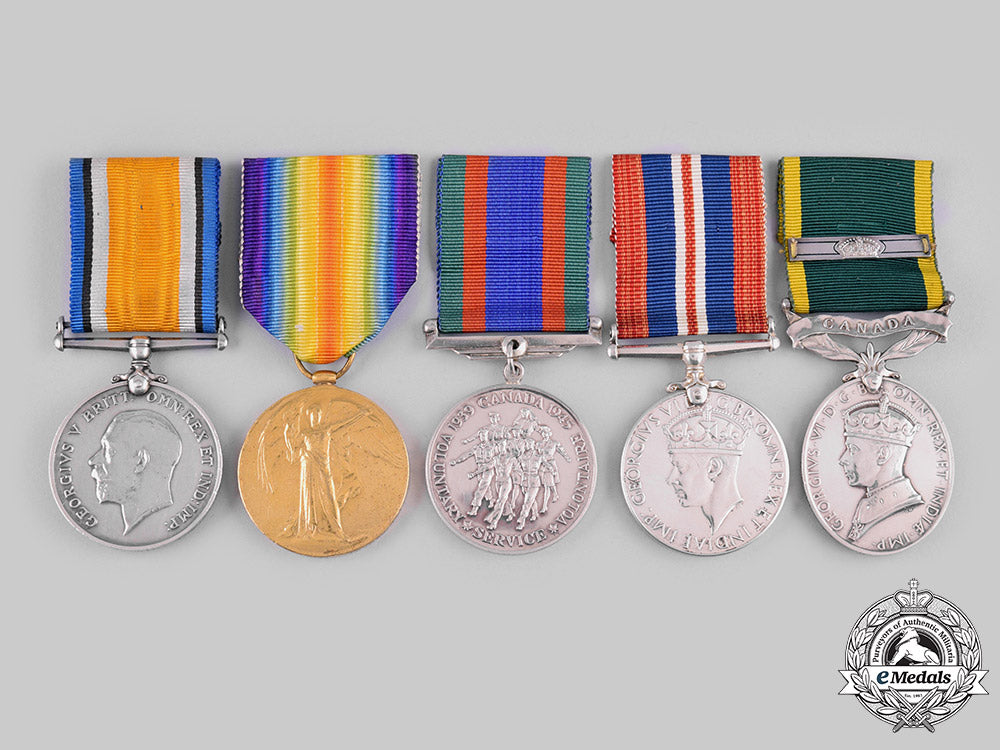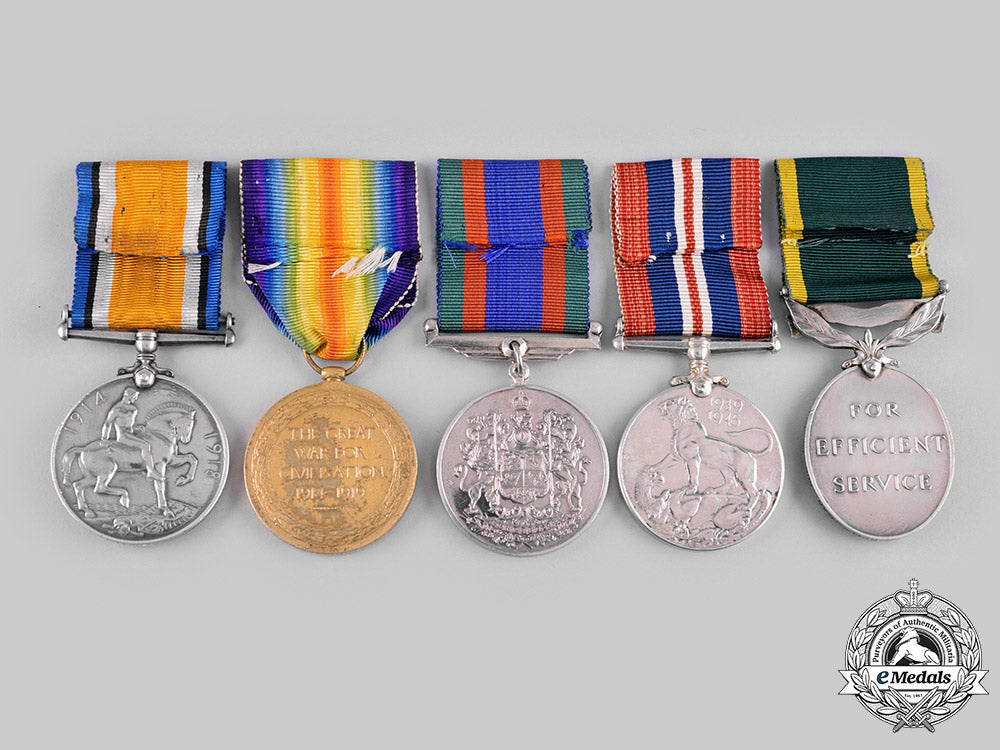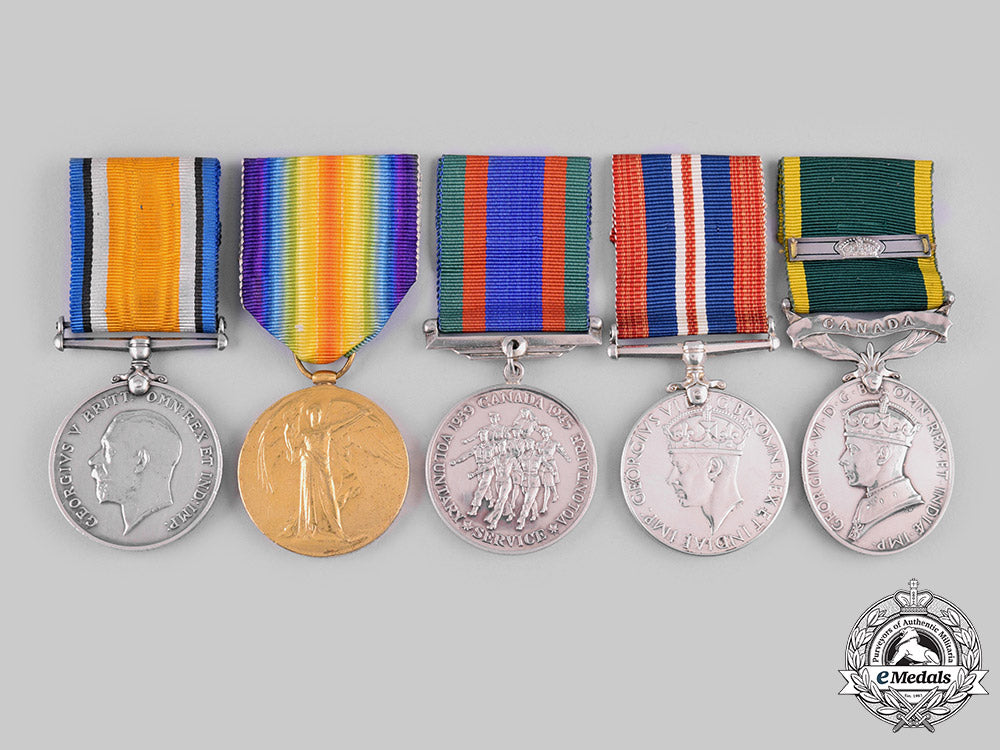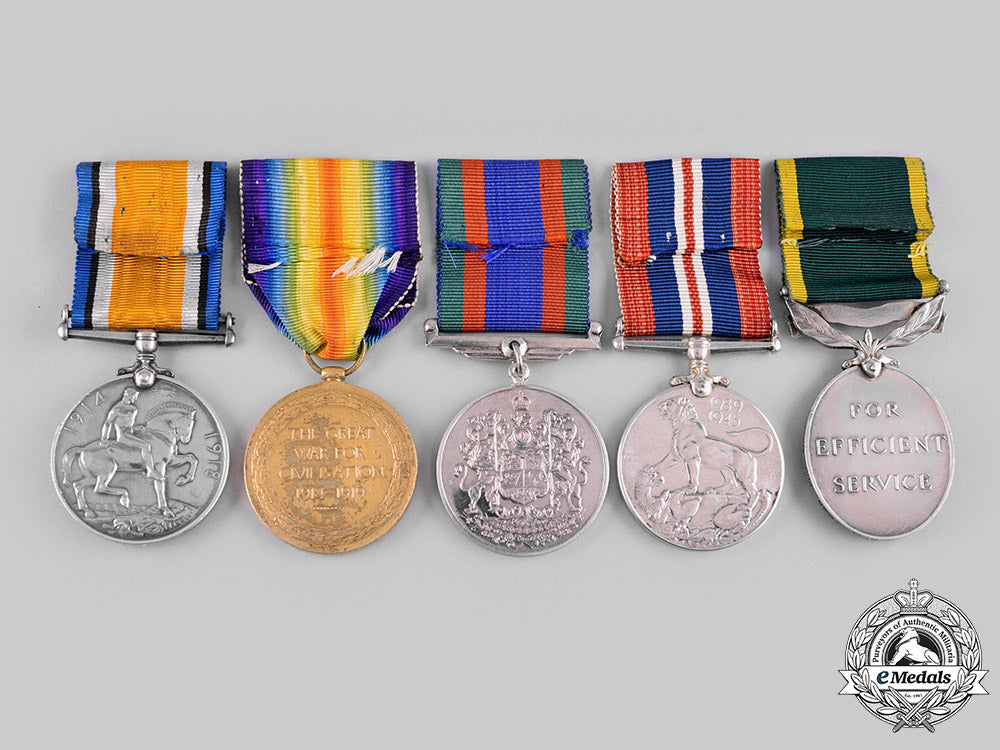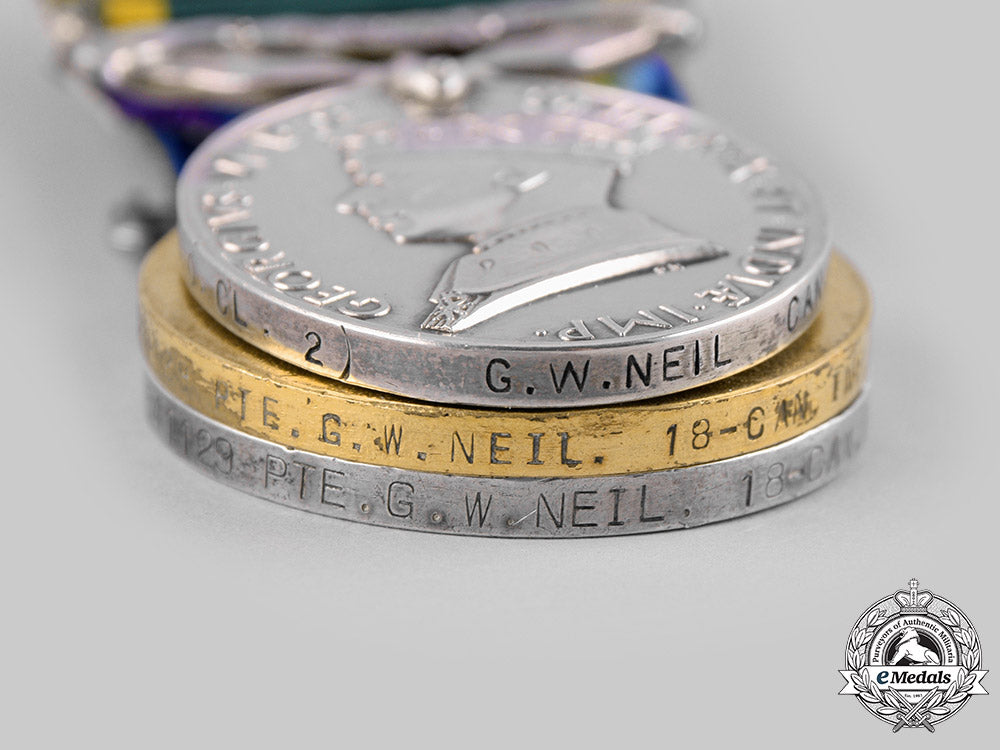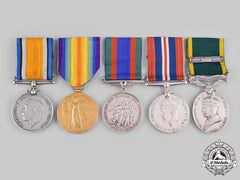
LOADING ...
In response to evolving domestic opinion, eMedals Inc has made the conscious decision to remove the presentation of German Third Reich historical artifacts from our online catalogue. For three decades, eMedals Inc has made an effort to preserve history in all its forms. As historians and researchers, we have managed sensitive articles and materials with the greatest of care and respect for their past and present social context. We acknowledge the growing sentiments put forth by the Canadian public and have taken proactive actions to address this opinion.
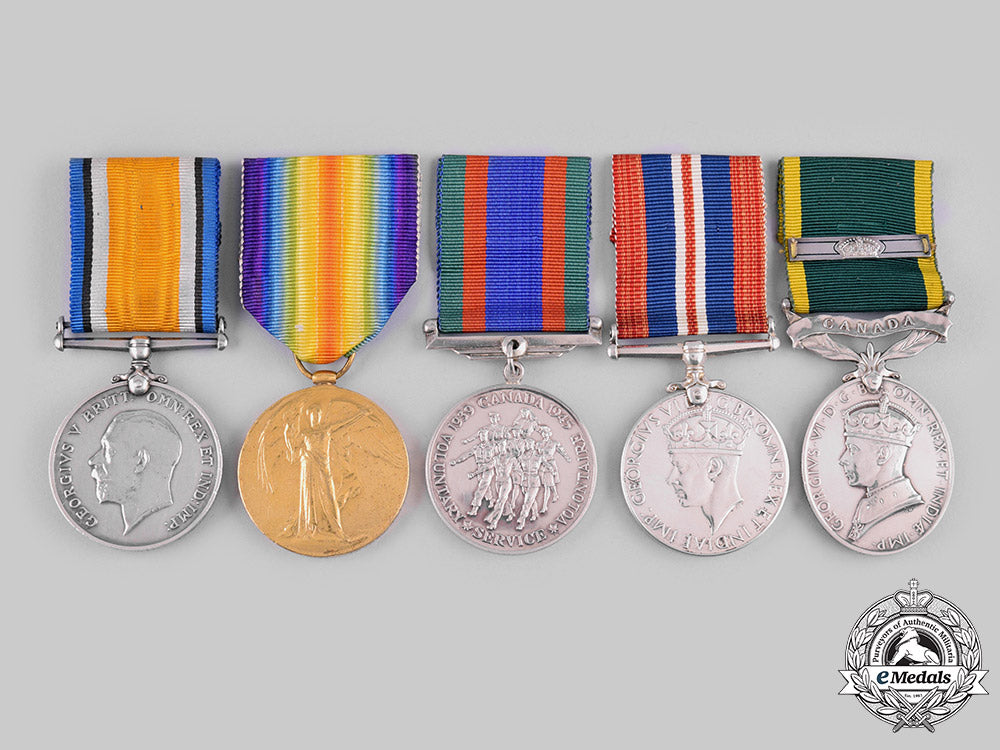
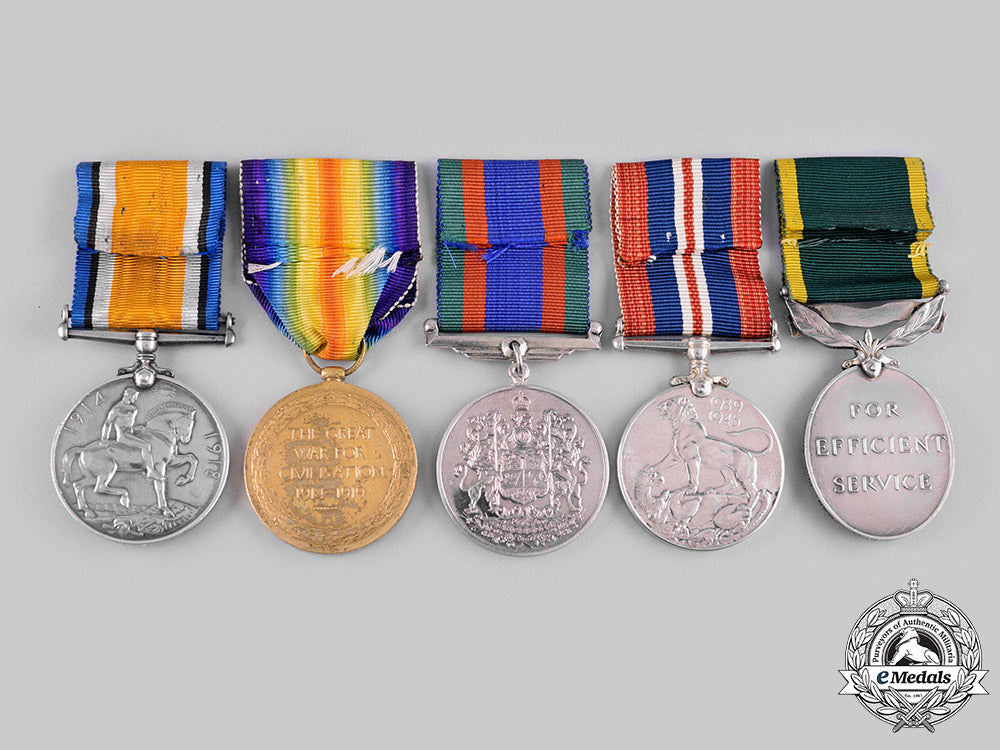
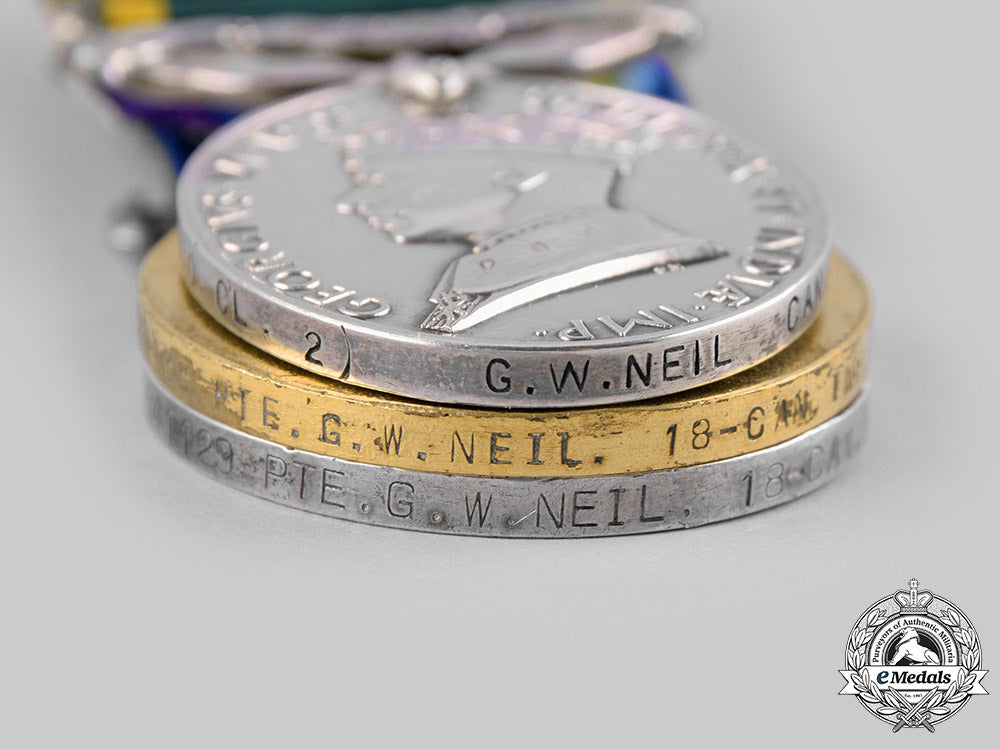
Canada. A First & Second War Efficiency Group, 18Th Infantry Battalion, Canadian Fusiliers, Rcoc
Canada. A First & Second War Efficiency Group, 18Th Infantry Battalion, Canadian Fusiliers, Rcoc
SKU: ITEM: C5992
Current Bid:
Your Max Bid:
Bid History:
Time Remaining:
Couldn't load pickup availability
Shipping Details
Shipping Details
eMedals offers rapid domestic and international shipping. Orders received prior to 12:00pm (EST) will be shipped on the same business day.* Orders placed on Canadian Federal holidays will be dispatched the subsequent business day. Courier tracking numbers are provided for all shipments. All items purchased from eMedals can be returned for a full monetary refund or merchandise credit, providing the criteria presented in our Terms & Conditions are met. *Please note that the addition of a COA may impact dispatch time.
Shipping Details
eMedals offers rapid domestic and international shipping. Orders received prior to 12:00pm (EST) will be shipped on the same business day.* Orders placed on Canadian Federal holidays will be dispatched the subsequent business day. Courier tracking numbers are provided for all shipments. All items purchased from eMedals can be returned for a full monetary refund or merchandise credit, providing the criteria presented in our Terms & Conditions are met. *Please note that the addition of a COA may impact dispatch time.
Description
Description
British War Medal (541129 PTE. G. W. NEIL. 18-CAN.INF.); Victory Medal (541129 PTE. G. W. NEIL. 18-CAN.INF.); Canadian Volunteer Service Medal; War Medal 1939-1945; and Efficiency Medal with Canada scroll and Six Years' Additional Service clasp, George VI (C.S.M. (W.O. CL. 2) G. W. NEIL CAN. FUS. (M.G.)). Naming is officially impressed on the First War pair and on the EM, the Second War pair are un-named as issued. Un-mounted, edge nicks on the BWM and EM, gilt wear on the VM, most with original ribbons, very fine. Accompanied by copies of his First War Index Cards, Attestation Paper, Service Records, Medical Records and Discharge Certificates, his Second War Attestation Paper, Service Records and Discharge Certificates, along with copies of various Newspaper Articles.
Footnote: George William Neil was born on December 14, 1899 in London, Ontario, the son of George Neil and Jane E. Neil. He signed his Attestation Paper as a Private (541129) with the 4th Divisional Cyclists Corps, Canadian Expeditionary Force, at the 4th Divisional Cyclists Depot, on November 29, 1915 in London, Ontario, at the age of 18, naming is next-of-kin as his mother, Jane E. Neil of London, stating that he had no previous military service, that he was not married, that his religion was Church of England and that his trade was that of Bell Boy. He was admitted to hospital while in Toronto on April 12, 1916 for a case of "Tonsillitis", a stay that would entail ten days, before being discharged on the 22nd. Private Neil embarked Halifax, Nova Scotia aboard the S.S. Baltic on May 16, 1916, arriving in England on May 29th and was taken on strength as Chiseldon. He was transferred to the 4th Reserve Battalion on June 19th. In the Fall, Private Neil was admitted to Camp Hospital at Chiseldon on September 27, 1916, with a contusion to his toe. After nine days' treatment, he was "cured" and discharged on October 6th. One year later, Private Neil received his orders to proceed overseas for service in the French theatre on September 26, 1917, where he would be posted to the 18th Infantry Battalion. He arrived at No. 2 Canadian Infantry Base Depot at Etaples on September 27th, then posted to the Canadian Corps Reinforcement Camp on October 2nd. Private Neil would come to join the 18th Infantry Battalion, "A" Company in the field on December 12, 1917. He attended a course at the 2nd Divisional Wing, Canadian Casualty Assembly Centre on February 22, 1918 and attended the 4th Canadian Infantry Brigade Work Party on May 19, 1918. Private Neil was in action on August 8, 1918 when he received a gun shot wound (shrapnel) to his face (scalp). He was admitted to No. 10 General Hospital at Rouen on the 9th, then transferred to No. 5 Ambulance Train on the 14th, followed by his admission to No. 73 General Hospital at Trouville the same day. After five days at Trouville, he was transferred and admitted to No. 14 Convalescent Depot on the 19th, where he would recuperate for the next eighteen days, before being discharged to Base Details on September 6th. His wounding was acknowledged in an article in the London Free Press on Tuesday, August 20, 1918. He arrived at the Canadian Corps Reinforcement Camp on September 18, 1918 and was employed on Traffic Control duties with the Assistant Provost Marshal (APM), Canadian Corps, on October 2, 1918, before rejoining the 18th Infantry Battalion on the 21st. Private Neil was hospitalized once again, as he was admitted to No. 1 Canadian Casualty Clearing Station with "P.U.O." (Pyrexia of Unknown Origin = fever) on November 25, 1918. After almost two weeks, he was taken by No. 1 Ambulance Train to No. 21 Casualty Clearing Station on December 7th, then transferred to No. 9 Canadian General Hospital at Rouen the same day, where he was diagnosed with a case of "Influenza". Four days later, he was transferred and admitted to to No. 73 General Hospital at Trouville on the 11th, where he would be treated for the next twenty-five days, before being transferred to No. 14 Convalescent Depot on January 5, 1919 for seventeen days recuperation, before being discharged on the 22nd. He returned to England a week later, where he was posted to the Western Ontario Regimental Depot on January 30, 1919. He was placed on command to the Canadian Corps Camp at Kinmel Park, Rhyl, North Wales for return to Canada, on February 22, 1919.
He embarked from Liverpool aboard the S.S. Cretic on March 18, 1919, arriving in Halifax, Nova Scotia on the 22nd. Private George William Neil, 18th Infantry Battalion was discharged upon demobilization at No. 1 District Depot in London, Ontario, on March 27, 1919, entitled to wear the War Service Badge, Class "A", number 84485. For his First World War service, he was awarded the British War Medal and the Victory Medal. George William Neil married Annie Elizabeth Moss in St. Thomas, Ontario on December 28, 1919. He was a resident of London, Ontario when he signed his Permanent Force of Canada Attestation Paper as a Private (12928) with the Royal Canadian Regiment, on December 22, 1920 in London, stating that he had served for 3 years and 120 days with the 18th Infantry Battalion CEF, that he was Married (Separated status), that his religion was Church of England and that his trade was that of Commercial Traveller. The attending physician noted during his examination that Neil had a tattoo of a maple leaf butterfly on his left forearm. He officially joined the regiment on January 4, 1921, but was struck off strength seventeen days later as "Medically Unfit" on the 23rd. However, he eventually did re-enlist for service, serving with the Canadian Machine Gun Corps from March 1924 to December 1936 and with the Canadian Fusiliers (Machine Gun) from December 1936 to June 16, 1941, in the rank of Company Sergeant Major (Warrant Officer Class 2). He left the Canadian Fusiliers to join the Second World War effort, signing his Canadian Active Service Force Attestation Paper as a Private (A64121) with the Central Mechanization Depot, Royal Canadian Ordnance Corps, on June 17, 1941 in London, Ontario, naming his next-of-kin as his wife, Edith Nettie Neil of London, stating that he belonged to an Active Militia, the Canadian Fusiliers from June 1940 to June 1941, that he had previous service with the 18th Infantry Battalion CEF from November 1915 to March 1919, that he was Married, that his religion was United Church and that his trade was that of Caterer (also acknowledged as Mimeograph Repair Man, Laboratory Technician). He was attached to the recruiting staff at Military District No. 1 in London. Neil was to be Acting Corporal on August 5, 1941 and then to be Acting Sergeant the same day. He applied for the Efficiency Decoration at London on August 11, 1942, having accrued 17 years, 6 months and 10 days service and was awarded the Efficiency Medal with one clasp in March 1943, the announcement of the award of the medal appearing in the Canada Gazette of April 3, 1943, page 1411 and for the clasp in the same edition, on page 1412. Neil was promoted to Lance Corporal on May 1, 1943, then promoted to Acting Corporal on July 16, 1943, followed by a promotion to Acting Sergeant on September 4, 1944. He qualified as a Driver IC Class III on October 24th and was confirmed in the rank of Sergeant on December 16th. Sergeant George William Neil, Central Mechanization Depot, Royal Canadian Ordnance Corps was discharged "to return to civil life (on compassionate grounds)" at No. 1 District Depot in London on January 19, 1945. During his medical examination, the doctor noted that Neil had a tattoo of a winged wheel and maple leaf on his left forearm. For his Second World War service, he was awarded the Canadian Volunteer Service Medal and the War Medal 1939-1945. Neil would go on to become a pastor at the United Church in Camlachie, Ontario, just west of Sarnia and was there for several years in that capacity. On Saturday, October 23, 1948, he was driving a car with his wife as the passenger, on Egremont Road west of the town Camlackie, on their way to their home in London about 8:40 p.m. in dense fog, with limited visibility, when the car he was driving was in collision with another machine at the intersection of No. 21 Highway. Neil suffered severe head injuries resulting in a brain hemorrhage, remaining unconscious and in critical condition at Sarnia General Hospital. His wife, Edith escaped with lacerations and bruises. George William Neil died from his injuries on Tuesday, October 26, 1948, at the age of 48. He was survived by his wife, Edith, a daughter, Mrs. Ernest Swindall of London, and a son, George Neil in the RCAF who was stationed at Sea Island, British Columbia. Neil's funeral was held at Camlachie United Church on Thursday, October 28th, followed by his burial in Forest Lawn Memorial Gardens in London. As a side note, his father, George Neil also served during the Great War. He was born on August 27, 1876 in London, Ontario and enlisted for overseas service in August 1914 at Strathroy, Ontario. He signed his Attestation Paper as a Private (6586) with the 1st Infantry Battalion "Ontario Regiment", on September 20, 1914 at Valcartier Camp, at the age of 38, naming his next-of-kin as his wife, Mrs. George Neil (Jennie Neil, possibly Jane E. Neil) of London, stating that he was with an Active Militia, that he was Married, that his religion was Church of England and that his trade was that of Cook. The Battalion was raised in Southwestern Ontario with mobilization headquarters at Camp Valcartier under the authority of P.C.O. 2067, August 6, 1914.
The Battalion sailed from Quebec City, Quebec aboard the S.S. Laurentic on October 3, 1914, under the command of Lieutenant-Colonel F.W. Hill with a strength of 47 officers and 1,106 other ranks. The elder Private Neil sustained a head wound during the 1st Infantry Battalion's April 22, 1915 attack on Mauser Ridge, during the Second Battle of Ypres, in Belgium. He was admitted to No. 5 Casualty Clearing Station with a gun shot wound (shrapnel) to the head. He was later admitted to No. 2 General Hospital at Le Havre, then discharged to reinforcements on May 12, 1915 and posted to Base at Le Havre on May 13th. Private Neil was transferred to England for discharge "on cessation of working pay" on August 14, 1916. He was sent home for discharge as of August 18th, entitled to wear the Good Conduct Badge and was struck off strength on proceeding to Canada for discharge on September 30, 1916. 6586 Private George Neil, 1st Infantry Battalion (father of George William Neil) was "discharged in consequence of Canadian Order in Council dated 16th November 1915, allowing all men of the Canadian Expeditionary Force in receipt of Working Pay on that date to take their discharge if not satisfied to continue their service", on October 20, 1916 at the Discharge Depot in Quebec City, Quebec, credited with having served in Canada, England, France and Belgium. For his First World War service, he was awarded the 1914-15 Star, the British War Medal and the Victory Medal. He died in London, Ontario, on March 20, 1917, at the age of 40, his death attributed to the wounds he sustained overseas. He is buried in London (Woodland) Cemetery in London, Ontario, Grave Reference: Section D. 191. A First War grave marker was erected at his final resting place, the marker inscribed "5686 PRIVATE GEORGE NEIL / 1st BATTn C.E.F. / 20th MARCH 1917 / YOU BLED THERE, TOO. / I TAKE YOU IN MY ARMS.". He is also commemorated on page 477 of the First World War Book of Remembrance.
Description
British War Medal (541129 PTE. G. W. NEIL. 18-CAN.INF.); Victory Medal (541129 PTE. G. W. NEIL. 18-CAN.INF.); Canadian Volunteer Service Medal; War Medal 1939-1945; and Efficiency Medal with Canada scroll and Six Years' Additional Service clasp, George VI (C.S.M. (W.O. CL. 2) G. W. NEIL CAN. FUS. (M.G.)). Naming is officially impressed on the First War pair and on the EM, the Second War pair are un-named as issued. Un-mounted, edge nicks on the BWM and EM, gilt wear on the VM, most with original ribbons, very fine. Accompanied by copies of his First War Index Cards, Attestation Paper, Service Records, Medical Records and Discharge Certificates, his Second War Attestation Paper, Service Records and Discharge Certificates, along with copies of various Newspaper Articles.
Footnote: George William Neil was born on December 14, 1899 in London, Ontario, the son of George Neil and Jane E. Neil. He signed his Attestation Paper as a Private (541129) with the 4th Divisional Cyclists Corps, Canadian Expeditionary Force, at the 4th Divisional Cyclists Depot, on November 29, 1915 in London, Ontario, at the age of 18, naming is next-of-kin as his mother, Jane E. Neil of London, stating that he had no previous military service, that he was not married, that his religion was Church of England and that his trade was that of Bell Boy. He was admitted to hospital while in Toronto on April 12, 1916 for a case of "Tonsillitis", a stay that would entail ten days, before being discharged on the 22nd. Private Neil embarked Halifax, Nova Scotia aboard the S.S. Baltic on May 16, 1916, arriving in England on May 29th and was taken on strength as Chiseldon. He was transferred to the 4th Reserve Battalion on June 19th. In the Fall, Private Neil was admitted to Camp Hospital at Chiseldon on September 27, 1916, with a contusion to his toe. After nine days' treatment, he was "cured" and discharged on October 6th. One year later, Private Neil received his orders to proceed overseas for service in the French theatre on September 26, 1917, where he would be posted to the 18th Infantry Battalion. He arrived at No. 2 Canadian Infantry Base Depot at Etaples on September 27th, then posted to the Canadian Corps Reinforcement Camp on October 2nd. Private Neil would come to join the 18th Infantry Battalion, "A" Company in the field on December 12, 1917. He attended a course at the 2nd Divisional Wing, Canadian Casualty Assembly Centre on February 22, 1918 and attended the 4th Canadian Infantry Brigade Work Party on May 19, 1918. Private Neil was in action on August 8, 1918 when he received a gun shot wound (shrapnel) to his face (scalp). He was admitted to No. 10 General Hospital at Rouen on the 9th, then transferred to No. 5 Ambulance Train on the 14th, followed by his admission to No. 73 General Hospital at Trouville the same day. After five days at Trouville, he was transferred and admitted to No. 14 Convalescent Depot on the 19th, where he would recuperate for the next eighteen days, before being discharged to Base Details on September 6th. His wounding was acknowledged in an article in the London Free Press on Tuesday, August 20, 1918. He arrived at the Canadian Corps Reinforcement Camp on September 18, 1918 and was employed on Traffic Control duties with the Assistant Provost Marshal (APM), Canadian Corps, on October 2, 1918, before rejoining the 18th Infantry Battalion on the 21st. Private Neil was hospitalized once again, as he was admitted to No. 1 Canadian Casualty Clearing Station with "P.U.O." (Pyrexia of Unknown Origin = fever) on November 25, 1918. After almost two weeks, he was taken by No. 1 Ambulance Train to No. 21 Casualty Clearing Station on December 7th, then transferred to No. 9 Canadian General Hospital at Rouen the same day, where he was diagnosed with a case of "Influenza". Four days later, he was transferred and admitted to to No. 73 General Hospital at Trouville on the 11th, where he would be treated for the next twenty-five days, before being transferred to No. 14 Convalescent Depot on January 5, 1919 for seventeen days recuperation, before being discharged on the 22nd. He returned to England a week later, where he was posted to the Western Ontario Regimental Depot on January 30, 1919. He was placed on command to the Canadian Corps Camp at Kinmel Park, Rhyl, North Wales for return to Canada, on February 22, 1919.
He embarked from Liverpool aboard the S.S. Cretic on March 18, 1919, arriving in Halifax, Nova Scotia on the 22nd. Private George William Neil, 18th Infantry Battalion was discharged upon demobilization at No. 1 District Depot in London, Ontario, on March 27, 1919, entitled to wear the War Service Badge, Class "A", number 84485. For his First World War service, he was awarded the British War Medal and the Victory Medal. George William Neil married Annie Elizabeth Moss in St. Thomas, Ontario on December 28, 1919. He was a resident of London, Ontario when he signed his Permanent Force of Canada Attestation Paper as a Private (12928) with the Royal Canadian Regiment, on December 22, 1920 in London, stating that he had served for 3 years and 120 days with the 18th Infantry Battalion CEF, that he was Married (Separated status), that his religion was Church of England and that his trade was that of Commercial Traveller. The attending physician noted during his examination that Neil had a tattoo of a maple leaf butterfly on his left forearm. He officially joined the regiment on January 4, 1921, but was struck off strength seventeen days later as "Medically Unfit" on the 23rd. However, he eventually did re-enlist for service, serving with the Canadian Machine Gun Corps from March 1924 to December 1936 and with the Canadian Fusiliers (Machine Gun) from December 1936 to June 16, 1941, in the rank of Company Sergeant Major (Warrant Officer Class 2). He left the Canadian Fusiliers to join the Second World War effort, signing his Canadian Active Service Force Attestation Paper as a Private (A64121) with the Central Mechanization Depot, Royal Canadian Ordnance Corps, on June 17, 1941 in London, Ontario, naming his next-of-kin as his wife, Edith Nettie Neil of London, stating that he belonged to an Active Militia, the Canadian Fusiliers from June 1940 to June 1941, that he had previous service with the 18th Infantry Battalion CEF from November 1915 to March 1919, that he was Married, that his religion was United Church and that his trade was that of Caterer (also acknowledged as Mimeograph Repair Man, Laboratory Technician). He was attached to the recruiting staff at Military District No. 1 in London. Neil was to be Acting Corporal on August 5, 1941 and then to be Acting Sergeant the same day. He applied for the Efficiency Decoration at London on August 11, 1942, having accrued 17 years, 6 months and 10 days service and was awarded the Efficiency Medal with one clasp in March 1943, the announcement of the award of the medal appearing in the Canada Gazette of April 3, 1943, page 1411 and for the clasp in the same edition, on page 1412. Neil was promoted to Lance Corporal on May 1, 1943, then promoted to Acting Corporal on July 16, 1943, followed by a promotion to Acting Sergeant on September 4, 1944. He qualified as a Driver IC Class III on October 24th and was confirmed in the rank of Sergeant on December 16th. Sergeant George William Neil, Central Mechanization Depot, Royal Canadian Ordnance Corps was discharged "to return to civil life (on compassionate grounds)" at No. 1 District Depot in London on January 19, 1945. During his medical examination, the doctor noted that Neil had a tattoo of a winged wheel and maple leaf on his left forearm. For his Second World War service, he was awarded the Canadian Volunteer Service Medal and the War Medal 1939-1945. Neil would go on to become a pastor at the United Church in Camlachie, Ontario, just west of Sarnia and was there for several years in that capacity. On Saturday, October 23, 1948, he was driving a car with his wife as the passenger, on Egremont Road west of the town Camlackie, on their way to their home in London about 8:40 p.m. in dense fog, with limited visibility, when the car he was driving was in collision with another machine at the intersection of No. 21 Highway. Neil suffered severe head injuries resulting in a brain hemorrhage, remaining unconscious and in critical condition at Sarnia General Hospital. His wife, Edith escaped with lacerations and bruises. George William Neil died from his injuries on Tuesday, October 26, 1948, at the age of 48. He was survived by his wife, Edith, a daughter, Mrs. Ernest Swindall of London, and a son, George Neil in the RCAF who was stationed at Sea Island, British Columbia. Neil's funeral was held at Camlachie United Church on Thursday, October 28th, followed by his burial in Forest Lawn Memorial Gardens in London. As a side note, his father, George Neil also served during the Great War. He was born on August 27, 1876 in London, Ontario and enlisted for overseas service in August 1914 at Strathroy, Ontario. He signed his Attestation Paper as a Private (6586) with the 1st Infantry Battalion "Ontario Regiment", on September 20, 1914 at Valcartier Camp, at the age of 38, naming his next-of-kin as his wife, Mrs. George Neil (Jennie Neil, possibly Jane E. Neil) of London, stating that he was with an Active Militia, that he was Married, that his religion was Church of England and that his trade was that of Cook. The Battalion was raised in Southwestern Ontario with mobilization headquarters at Camp Valcartier under the authority of P.C.O. 2067, August 6, 1914.
The Battalion sailed from Quebec City, Quebec aboard the S.S. Laurentic on October 3, 1914, under the command of Lieutenant-Colonel F.W. Hill with a strength of 47 officers and 1,106 other ranks. The elder Private Neil sustained a head wound during the 1st Infantry Battalion's April 22, 1915 attack on Mauser Ridge, during the Second Battle of Ypres, in Belgium. He was admitted to No. 5 Casualty Clearing Station with a gun shot wound (shrapnel) to the head. He was later admitted to No. 2 General Hospital at Le Havre, then discharged to reinforcements on May 12, 1915 and posted to Base at Le Havre on May 13th. Private Neil was transferred to England for discharge "on cessation of working pay" on August 14, 1916. He was sent home for discharge as of August 18th, entitled to wear the Good Conduct Badge and was struck off strength on proceeding to Canada for discharge on September 30, 1916. 6586 Private George Neil, 1st Infantry Battalion (father of George William Neil) was "discharged in consequence of Canadian Order in Council dated 16th November 1915, allowing all men of the Canadian Expeditionary Force in receipt of Working Pay on that date to take their discharge if not satisfied to continue their service", on October 20, 1916 at the Discharge Depot in Quebec City, Quebec, credited with having served in Canada, England, France and Belgium. For his First World War service, he was awarded the 1914-15 Star, the British War Medal and the Victory Medal. He died in London, Ontario, on March 20, 1917, at the age of 40, his death attributed to the wounds he sustained overseas. He is buried in London (Woodland) Cemetery in London, Ontario, Grave Reference: Section D. 191. A First War grave marker was erected at his final resting place, the marker inscribed "5686 PRIVATE GEORGE NEIL / 1st BATTn C.E.F. / 20th MARCH 1917 / YOU BLED THERE, TOO. / I TAKE YOU IN MY ARMS.". He is also commemorated on page 477 of the First World War Book of Remembrance.
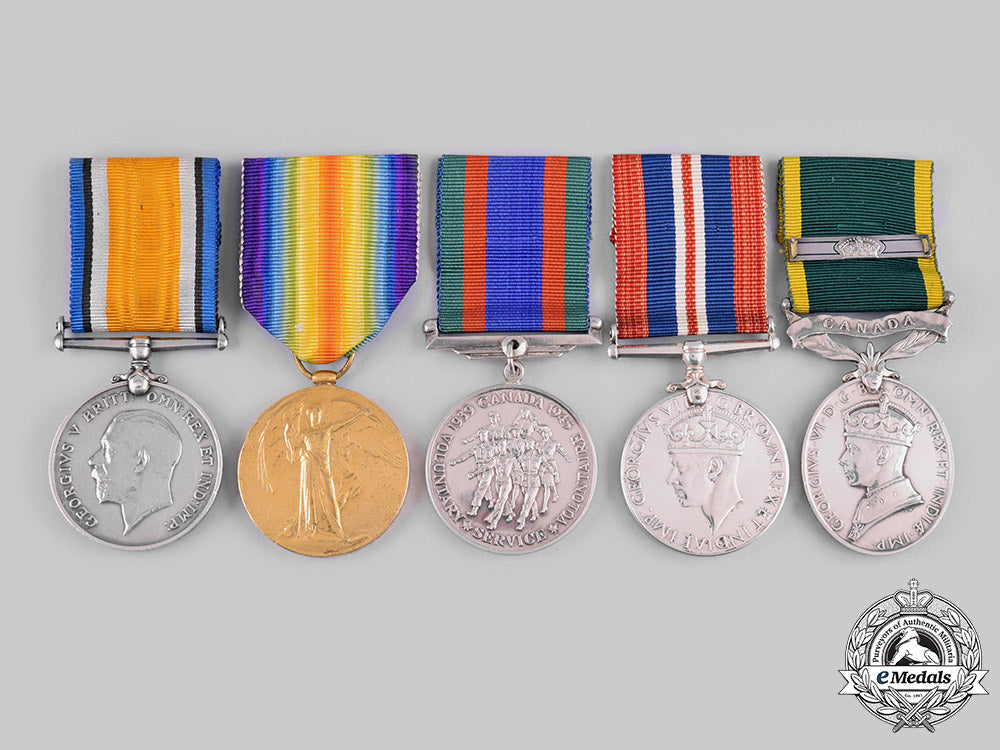
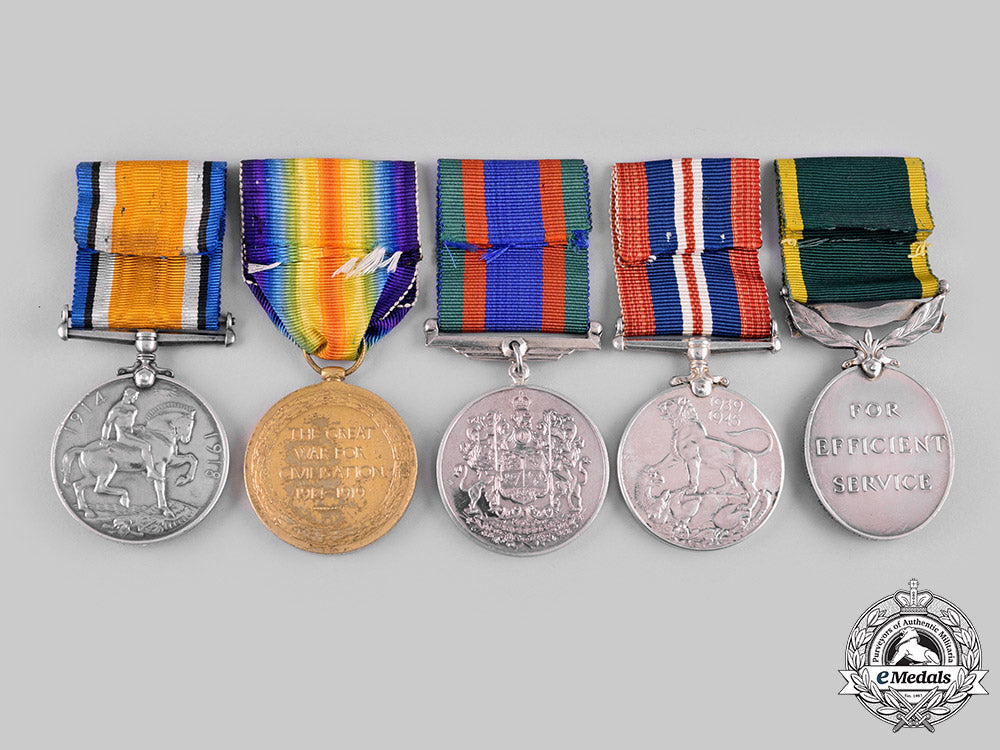
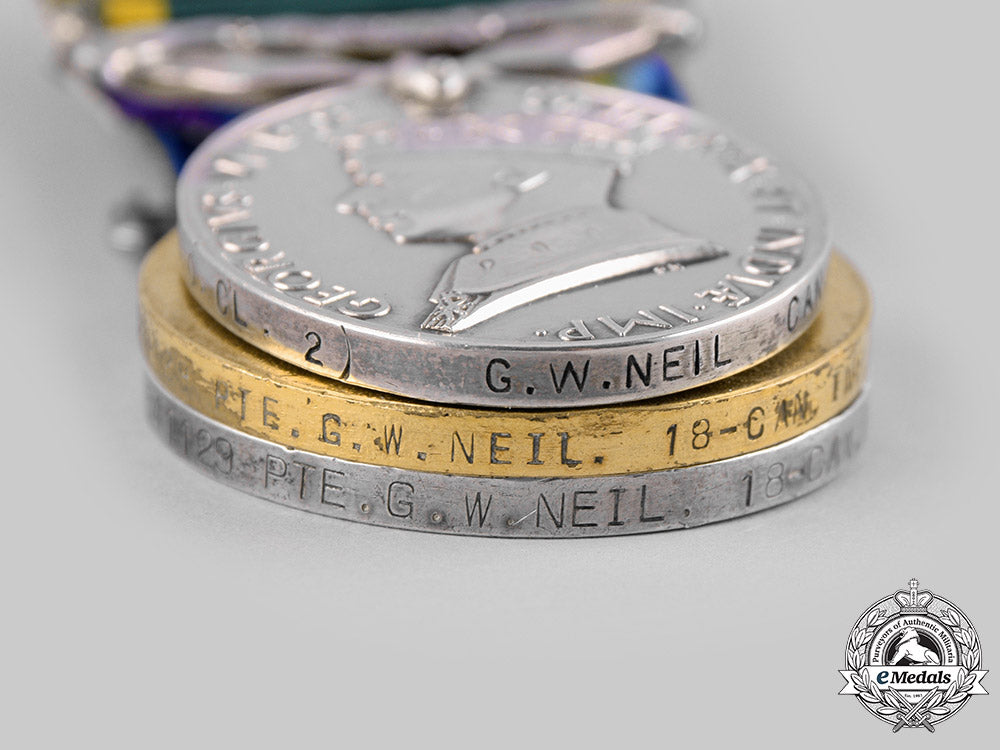
You May Also Like
Germany, Third Reich. A Mixed Lot of Tyrolean Marksmanship Badges
G52930
Germany, SS. An Estonian Waffen-SS Volunteer’s Sleeve Shield
G50381
Germany, SS. A Waffen-SS Sturmmann Sleeve Insignia
G52846
Germany, Third Reich; Slovakia, First Republic. A Mixed Lot of Wartime Postcards
G52905
Germany, Third Reich. A Pair of Tyrolean Marksmanship Badges
G52981
-
Germany, Third Reich. A Mixed Lot of Tyrolean Marksmanship Badges
G52930
Add to CartRegular price $135 USDRegular price $0 USD Sale price $135 USDUnit price / per -
Germany, SS. An Estonian Waffen-SS Volunteer’s Sleeve Shield
G50381
Add to CartRegular price $150 USDRegular price $0 USD Sale price $150 USDUnit price / per -
Germany, SS. A Waffen-SS Sturmmann Sleeve Insignia
G52846
Add to CartRegular price $135 USDRegular price $0 USD Sale price $135 USDUnit price / per -
Germany, Third Reich; Slovakia, First Republic. A Mixed Lot of Wartime Postcards
G52905
Add to CartRegular price $135 USDRegular price $0 USD Sale price $135 USDUnit price / per -
Germany, Third Reich. A Pair of Tyrolean Marksmanship Badges
G52981
Add to CartRegular price $135 USDRegular price $0 USD Sale price $135 USDUnit price / per
Do you have a similar item you are interested in selling?
Please complete the form and our client care representatives will contact you.
Sell Item